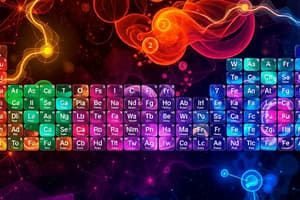Podcast
Questions and Answers
What is the main concept of the Periodic Law?
What is the main concept of the Periodic Law?
- Electrons determine the organization of the periodic table.
- Properties of elements recur periodically when arranged by atomic mass. (correct)
- The table only includes metals.
- Elements are arranged by their chemical properties.
Noble gases are known for their high reactivity.
Noble gases are known for their high reactivity.
False (B)
What are the three types of elements primarily listed in the periodic table?
What are the three types of elements primarily listed in the periodic table?
Representative Elements, Transition Metals, Noble Gases
The electron configuration for Sodium is _____
The electron configuration for Sodium is _____
Match the following groups of elements with their characteristics:
Match the following groups of elements with their characteristics:
Which group of elements is characterized by having two valence electrons?
Which group of elements is characterized by having two valence electrons?
The element with the symbol 'Br' belongs to the group of Noble Gases.
The element with the symbol 'Br' belongs to the group of Noble Gases.
What is the electron configuration for Magnesium?
What is the electron configuration for Magnesium?
Group 17 elements are known as _____
Group 17 elements are known as _____
Which of the following elements is isoelectronic with Argon?
Which of the following elements is isoelectronic with Argon?
Flashcards
Periodic Law
Periodic Law
The periodic table's main organizing principle, stating that elements' properties repeat when ordered by increasing atomic mass.
Group (Periodic Table)
Group (Periodic Table)
A set of elements with similar chemical properties due to having the same number of valence electrons.
Periods 1-3
Periods 1-3
The first, second, and third rows of elements on the periodic table.
Alkali Metals
Alkali Metals
Signup and view all the flashcards
Alkaline Earth Metals
Alkaline Earth Metals
Signup and view all the flashcards
Halogens
Halogens
Signup and view all the flashcards
Noble Gases
Noble Gases
Signup and view all the flashcards
Groups on the Periodic Table
Groups on the Periodic Table
Signup and view all the flashcards
Isoelectronic Species
Isoelectronic Species
Signup and view all the flashcards
Periodic Table Organization
Periodic Table Organization
Signup and view all the flashcards
Study Notes
Chapter 11: The Periodic Table
- The periodic table organizes elements based on recurring properties.
- Dmitri Mendeleev created the first periodic table in 1869.
- The table is organized by increasing atomic mass.
- Elements with similar properties are grouped together.
- Mendeleev left spaces in the table for undiscovered elements and predicted their properties.
Organizing by Properties
- Elements' properties repeat in a periodic pattern.
- Fundamental patterns in nature are recognized.
- Elements with repeating properties are grouped together.
Periodic Law
- Elements' properties repeat periodically when arranged by atomic mass.
Today's Table
- Elements grouped according to properties.
- Groups/Families (vertical columns)
- Periods (horizontal rows)
Groups/Families
- Vertical columns on the periodic table.
- Alkali metals (Group 1) react with water to form basic solutions.
- Alkaline earth metals (Group 2)
- Halogens (Group 17)
- Noble gases (Group 18)
- Transition metals (Groups 3-12)
Periods
- Horizontal rows on the periodic table.
- Number of elements varies between periods.
- Lanthanide and actinide series are grouped separately.
Patterns in Electron Structure
- Electron structures influence properties.
- Forces of attraction and repulsion in atoms affect structure.
Electron Configurations for Some Elements
- Valence electrons determine bonding.
- Alkali metals have one valence electron.
- Alkaline earth metals have two valence electrons.
- Halogens have seven valence electrons.
- Noble gases have eight valence electrons.
- Transition metals have varying numbers of d electrons.
Trends in Electron Configurations
- Valence electrons in outermost s and p orbitals.
- Atoms in the same column have similar valence electron configurations.
Summary
- Representative elements have valence electrons in s or p orbitals.
- Transition elements have valence electrons in d orbitals.
- Noble gases are unreactive due to filled outermost orbitals.
- Alkali metals lose one electron to form +1 ions.
- Alkaline earth metals lose two electrons to form +2 ions.
- Halogens gain one electron to form -1 ions.
Studying That Suits You
Use AI to generate personalized quizzes and flashcards to suit your learning preferences.




